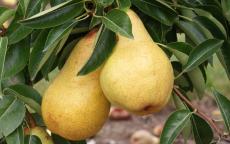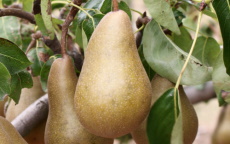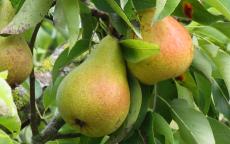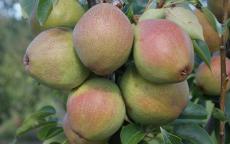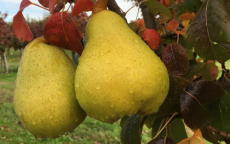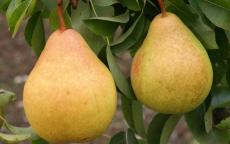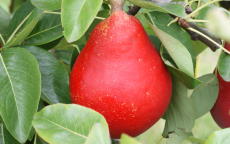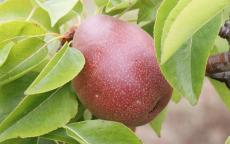Pear trees
We have an extensive range of pear trees and can advise on choosing the best pear trees for your garden or orchard project.
Aurora
An early-season American pear variety, related to Bartlett but with an improved flavor and better storage.- Self-fertility: Not self-fertile
- Pollination group: 3
Bartlett
A classic English pear, easy to grow, and a good flavor.- Self-fertility: Partially self-fertile
- Pollination group: 3
Beurre Bosc
A traditional French pear with buttery melting flesh.- Self-fertility: Not self-fertile
- Pollination group: 5
Blake's Pride
A modern fireblight resistant pear, which ripens mid-season, about a week later than Bartlett.- Self-fertility: Not self-fertile
- Pollination group: 3
Flemish Beauty
A traditional European pear from Belgium, with the classic rich sweet buttery melting flesh. Flemish Beauty is also self-fertile and cold-hardy.- Self-fertility: Self-fertile
- Pollination group: 3
Harrow Crisp
An attractive disease-resistant early-season pear with an orange flushed yellow skin, related to Bartlett and with a similar flavor.- Self-fertility: Not self-fertile
- Pollination group: 3
Harrow Delight
Harrow Delight is an early-season Bartlett-style pear with a sweet flavor and good disease-resistance.- Self-fertility: Not self-fertile
- Pollination group: 3
Harrow Sweet
A disease-resistant heavy-cropping late-season pear with an excellent sweet flavor for eating fresh.- Self-fertility: Not self-fertile
- Pollination group: 3
Honeysweet
Honeysweet is a self-fertile small late-season sweet pear, with buttery flesh, related to Seckel.- Self-fertility: Self-fertile
- Pollination group: 3
Kieffer
Kieffer is a late-season self-fertile dual-purpose pear, popular for wildlife planting and canning.- Self-fertility: Partially self-fertile
- Pollination group: 2
Magness
A high quality late-season eating pear, developed to be fireblight resistant.- Self-fertility: Not self-fertile
- Pollination group: 3
Maxine
Maxine is a traditional American pear, with good fire blight resistance.- Self-fertility: Not self-fertile
- Pollination group: 4
Moonglow
A high quality early season dessert and culinary pear, very resistant to fireblight.- Self-fertility: Not self-fertile
- Pollination group: 3
Potomac
Potomac is a modern late-season dessert pear, with good fireblight resistance- Self-fertility: Not self-fertile
- Pollination group: 3
Red Clapp's Favorite
A red form of Clapp's Favorite, also known as Kalle. The pears have a sweet flavor, and ripen in late summer.- Self-fertility: Not self-fertile
- Pollination group: 4
Seckel
The definitive American heirloom pear, found near Philadelphia in the 1760s. Fruits are small but have a rich sweet aromatic flavor.- Self-fertility: Partially self-fertile
- Pollination group: 4
Shenandoah
Shenandoah is a late-season Bartlett-style pear, with a rich sweet/sharp flavor.- Self-fertility: Not self-fertile
- Pollination group: 3
How to choose Pear trees
Pears are related to apples, and most of the horticultural requirements and challenges of apples apply also to growing pear trees. However pear trees are a bit more demanding than apple trees - they prefer slightly warmer conditions and are a bit less tolerant of soil and situation, and crop yields are lower.
On the plus side, pear trees are less susceptible to the various pests and diseases commonly experienced with apples.
When it comes to flavor, pears have an aura of exclusivity which you don't tend to find in apples.
Pears are fundamentally self-sterile so will require a pollination partner, in other words a compatible pear tree of a different variety growing nearby. Even the varieties we list as self-fertile will be far more productive with a pollination partner.

